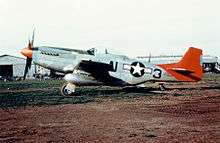Willie Rogers (Tuskegee)
MSgt. Willie Rogers (1915-2016) was a member of the famed group of World War II-era African-Americans known as the Tuskegee Airmen. He was shot twice in Italy during World War II. He was awarded the Congressional Gold Medal in 2007. [1]
Master Sergeant Willie Rogers | |
|---|---|
 Willie Rogers in 1943 | |
| Birth name | Willie N. Rogers |
| Born | April 12, 1915 Apalachicola, Florida |
| Died | November 18, 2016 (aged 101) St. Petersburg, Florida |
| Service/ | United States Army Air Force |
| Years of service | 1942-1945 |
| Rank | Master sergeant |
| Unit | 100th Fighter Squadron |
| Awards | |
Military service
World War II

Rogers was drafted into the United States Army 1942. He was sent to the European theater of the war, and served in a support role in logistics.[3]
During a mission in Italy in 1943, he was wounded in action. He was shot twice, once in the stomach and once in the leg by German soldiers. Rogers spent several months recovering in a London Hospital.[4]
Rogers arrived at the Dachau concentration camp in Germany shortly after it was liberated by American troops April 29, 1945. He and a contingent of Americans took an inventory of the camp.[5]
Rogers did not tell his family that he was a member of the Tuskegee Airmen until 2012. His family then pursued recognition and he received his Congressional Gold Medal in 2013. There is a portrait of Rogers hanging in the St. Petersburg Museum of History.[5][4][6]
Controversy
It was reported that Rogers was part of the 100th Fighter Squadron. However after his death historians were unsure about Rogers place in the history of the Tuskegee airmen. In 2017 it was confirmed that he as part of the 96th Air Service Group providing support to the pilots and air crews. Because Rogers never talked about his service until 2012, the story of his participation with the 100th Fighter Squadron was retold over and over.[7]
Awards
- Congressional Gold Medal (2007)[5]
Education
- Claflin College of Agriculture and Mechanical Institute[3]
- Tuskegee Institute (1942)
Personal life
Rogers was married and had children.[5] He returned to Florida after WWII and opened Rogers’ Radio Sales and Service in St. Petersburg. He was a lifelong member of the African Methodist Episcopal Church.[3] In 2016 at 101 years old Rogers died of a stroke.[4]
References
- "Willie Rogers, the oldest surviving member of the Tuskegee Airmen, dies at 101". Los Angeles Times. Associated Press. November 21, 2016. Retrieved September 23, 2019.
- Rice, Markus. "The Men and Their Airplanes: The Fighters." Tuskegee Airmen, 1 March 2000.
- "Willie Rogers". redtail. CAF Red Tail Squadron. Retrieved September 23, 2019.
- Toppo, Greg (November 20, 2016). "Tuskegee Airman dies at 101 after stroke". USA Today. Retrieved September 23, 2019.
- Guzzo, Paul (November 21, 2016). "Oldest remaining Tuskegee Airman, a St. Petersburg man, dies at 101". Tampa Bay Times. Retrieved September 23, 2019.
- Toppo, Greg. "Willie Rogers, Tuskegee Airman, dies at 101 after stroke". airforcetimes. Sightline Media Group. Retrieved September 23, 2019.
- Guzzo, Paul (May 2, 2017). "Tampa Bay area Tuskegee Airman deserved name for work he did on the ground". Tampa Bay Times. Retrieved September 23, 2019.
Notes
- The red markings that distinguished the Tuskegee Airmen included red bands on the noses of P-51s as well as a red rudder; their P-51B and D Mustangs flew with similar color schemes, with red propeller spinners, yellow wing bands and all-red tail surfaces.[2]
External links
- Tuskegee Airmen at Tuskegee University
- Tuskegee Airmen Archives at the University of California, Riverside Libraries.
- Tuskegee Airmen, Inc.
- Tuskegee Airmen National Historic Site (U.S. National Park Service)
- Tuskegee Airmen National Museum
- Fly (2009 play about the 332d Fighter Group)
- Executive Order 9981
- List of African American Medal of Honor recipients
- Military history of African Americans
